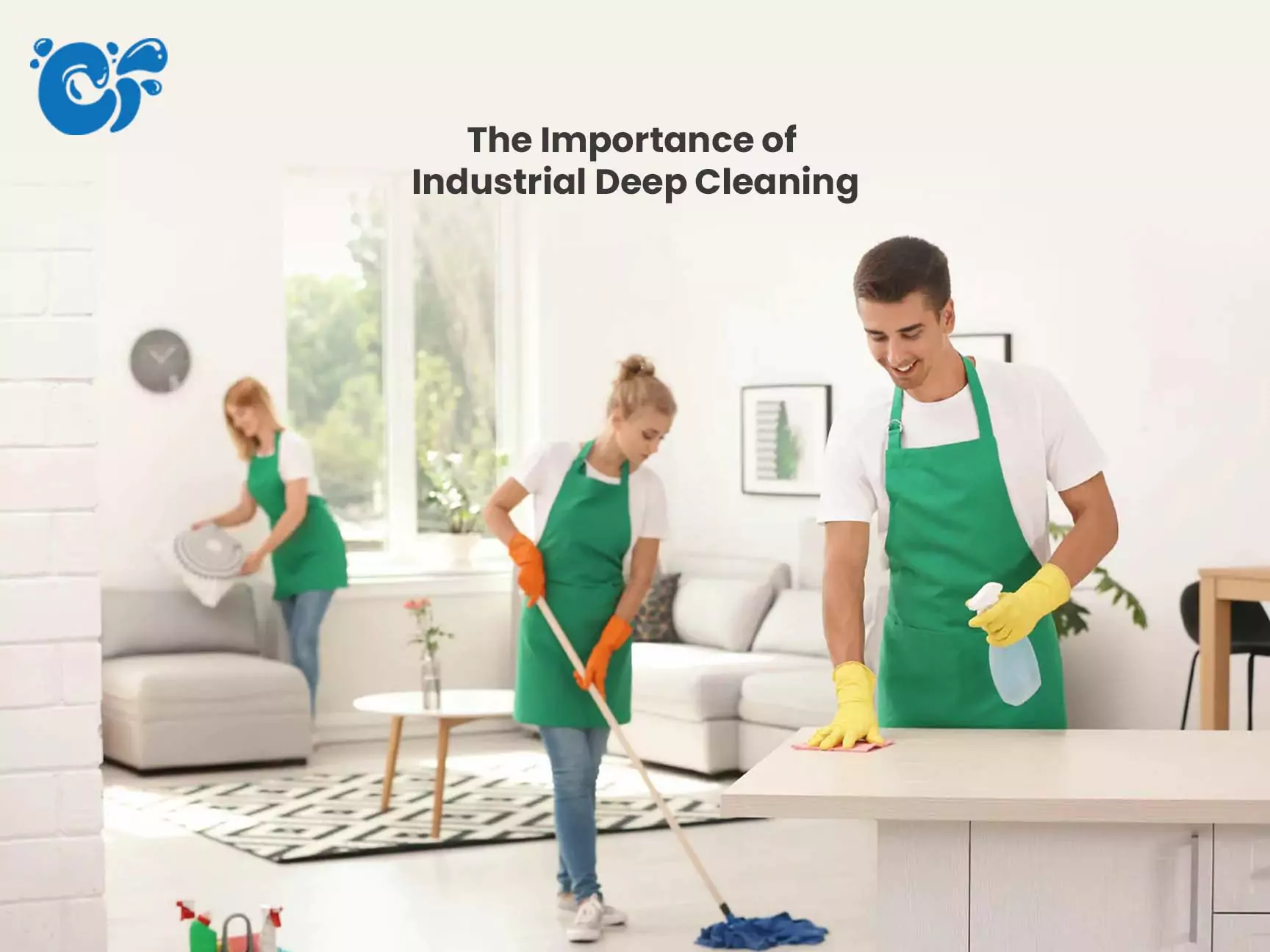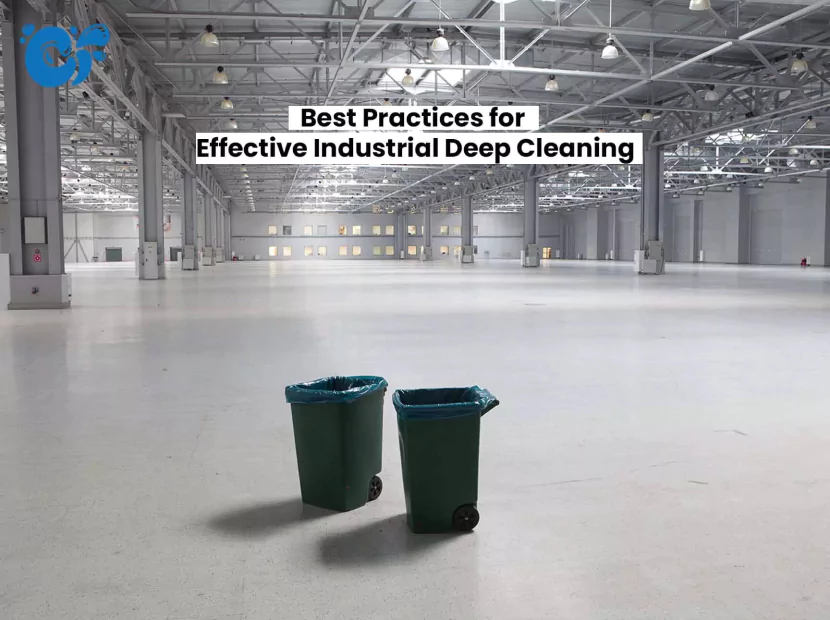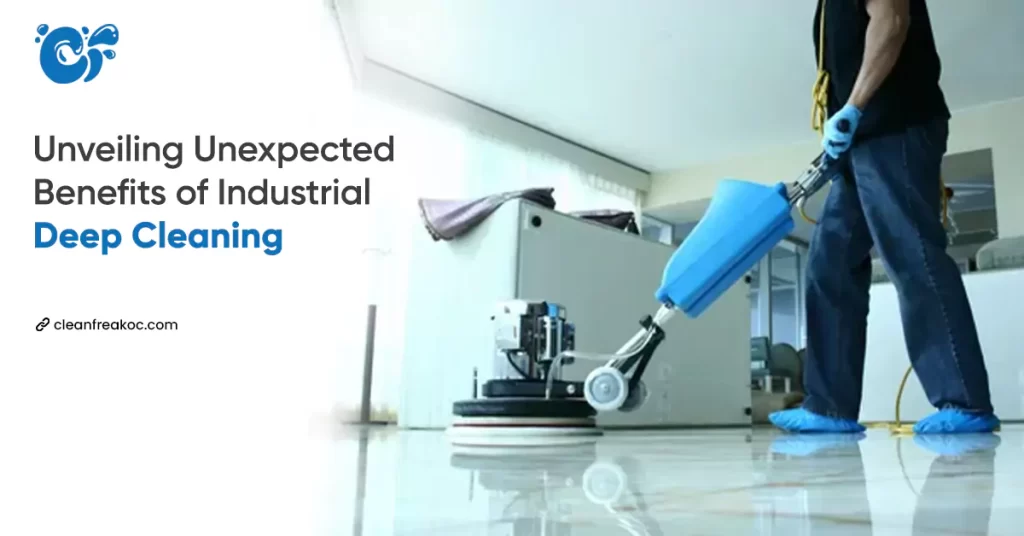Imagine entering a busy industrial complex where people are navigating a labyrinth of machines and buildings as the sound of machinery hums. Despite being vital to operations, hygiene is sometimes disregarded in this dynamic setting. Cleaning up the workspace is essential for safety, productivity, and regulatory compliance in fields where efficiency and precision are valued highly. It’s not only about appearances. This article will investigate industrial deep cleaning, including techniques and best practices for efficiently maintaining industrial buildings. We’ll find the valuable insights required to accomplish ideal cleanliness in the industrial sector, from comprehending the particular difficulties presented by industrial settings to putting efficient cleaning solutions catered to particular needs into practice. Let’s take a trip to explain industrial cleaning.
Key Takeaways
- Industrial deep cleaning makes the workplace environment friendly for workers, lowers the risk of infections and diseases, and ensures adherence to safety requirements and standards.
- It lessens the danger of catching allergies and other health issues by removing pollutants or bacteria, safeguarding worker health and wellbeing.
- By preventing rust and potential damage, deep cleaning regularly extends the life of industrial equipment and lowers the requirement for expensive repairs and replacements.
- A neat and organized workplace enhances employee productivity and efficiency, which eases the processes and boosts output.
- By ensuring adherence to industry norms and regulations, industrial cleaning helps prevent the charges, penalties, and legal ramifications of non-compliance.
The Importance of Industrial Deep Cleaning

Industry deep cleaning keeps hygienic conditions, safety regulations, and cleanliness in industrial settings. Having a spotless workplace is crucial for the health and productivity of workers. It goes both for manufacturing and warehousing facilities. Let’s explore the elements that highlight the significance of industrial deep cleaning.
Ensuring Workplace Safety
An industrial space has many risks related to cleanliness and safety. Industrial environments contain a variety of risks, such as garbage buildup, chemical spills, and slick surfaces. Reducing these hazards by rigorous cleaning gives workers a safer working environment.
Preserving the Health of Employees
A hygiene-friendly workspace is essential to safeguard employees’ health and well-being. Extracting pollutants, dust particles, and allergens lessens workers’ chances of respiratory and other health issues.
Keeping Up Regulatory Compliance
Strict regulations governing cleanliness and hygienic practices apply to industrial groups. By assisting them in avoiding fines and penalties, thorough cleaning services assist firms in adhering to industry standards and laws.
Maintaining Equipment Durability
Industrial equipment lasts longer when cleaned regularly, As rust, storage, and degradations are avoided. Businesses are able to save money on costly repairs and replacements by timely cleaning and maintaining machinery.
Enhancing Productivity and Efficiency
An orderly and spotless workspace improves efficiency and productivity among employees. Businesses may maximize output and ease operations by creating mess-free surroundings and optimized workflows.
Common Methods of Industrial Cleaning

Before diving into the components influencing industrial cleaning, it’s critical to comprehend the industry standard practices. A range of methods and strategies are made to address the particular difficulties of expansive settings, including manufacturing plants, warehouses, and industrial facilities, which are included in the category of industrial cleaning. Let’s examine a few of the most widely applied techniques for industrial cleaning.
Manual Cleaning Techniques
Manual cleaning practices are cleaning methods that require labor by hand. These involve wiping, scrubbing, mopping, and sweeping. Waste and floor dirt are removed from walls, floors, and equipment by using these techniques.
Sweeping and Mopping
Using brooms and mops, this simple yet effective technique removes loose dirt and debris before cleaning away any leftover filth.
Scrubbing and Wiping
To achieve a deeper clean, scrub stubborn stains and buildup with firm-bristled brushes and wipe with cloths or sponges.
Instruments and apparatus:
Handy tools like cleaners, filters, and cutters are helpful tools that simplify the removal of stubborn trash from hard-to-reach places.
Mechanical Cleaning Methods
The term “mechanical cleaning” refers to using specific machines for cleaning. It is used to bring better results that are more profound and comprehensive. The mechanical cleaning practices further include the following factors:
Pressure washing
This method uses an explosion to blow pollutants away. Using strong water streams, it cleans filth and dirt from surfaces like floors, walls, and equipment.
Steam Cleaning
The practice of steam cleaning provides complete disinfection without the use of tough chemicals by mixing dirt and grease stains with hot steam.
Utilizing Abrasive Blasting
The soda and sandblasting are the two most common abrasive blasting ways. By applying abrasive compounds to surfaces, we can get rid of rust, corrosion, and tough stains by using compressed air.
Chemical Cleaning Methods
Using specifically made cleaning chemicals and solutions, chemical cleaners remove stains, filth, and pollutants. However, different cleaning purposes call for different types of agents. Let’s examine a few of them in greater depth:
Products for preventive cleaning
Solvent cleaners are capable of clearing surfaces of oil, grease, and other hydrocarbon-based impurities.
Degreasers and lubricants
These constitute yet another kind of cleaner. Grease, oil, and filth are easily removed from surfaces because of their design, which breaks them down and dissolves them.
Sanitizers and disinfectants
Sanitizers and disinfectants fight well against bacteria, viruses, and other dangerous microbes. They help minimize the probability of infection and disease by reducing the overall amount of these pathogens.
Best Practices for Effective Industrial Deep Cleaning

Pre-Cleaning Preparations
For safe and effective cleaning, comprehensive preparations are essential. These preparations include choosing the right supplies and tools, making sure the area is clear of all potential hazards, and donning protective gear.
Inspection and Assessment
The basic practice includes analyzing the area in detail. Check the workspace thoroughly to find areas that need to be cleaned, and be cautious of any dangers or hazards.
Safety Measures and Equipment Checks
Make safety as priority by taking the necessary safety procedures, giving cleaning staff personal protective equipment (PPE), and ensuring that the equipment is in excellent operating order.
Proper Cleaning Techniques
Result-orienting cleaning practices are essential for optimal results and for preventing damage to floors and tools.
Surface-Specific Cleaning Methods
Different floors require different cleaning methods and products. Tailor cleaning techniques to suit the specific material and finish of each surface.
Correct Usage of Cleaning Agents and Equipment
Follow instructions added by manufacturers for the proper dilution, application, and usage of cleaning agents to emphasize cleanliness. It also maximizes effectiveness and minimizes waste.
Post-Cleaning Procedures
After cleaning, following up with post-cleaning procedures is essential to ensure quality control and environmental responsibility.
Inspection, Training, and Quality Control
A thorough inspection of the areas you’ve to ensure that all floors are adequately cleaned and sanitized to meet standards.
Waste Disposal and Environmental Considerations
Composing waste properly according to regulations and guidelines minimizes environmental impact and contamination risks. Hence, it’s one of the promising techniques for practicing industrial cleaning.
Continuous Improvement Strategies
It is essential to stay updated with recent cleaning methods. Continuous improvement is vital to maintaining high cleaning standards and adapting to changing needs and challenges.
Training and Education Programs
The finest ways to induce cleaning practice are training and educating cleaning workers to hone their skills, knowledge, and awareness of quality practices and safety protocols.
Feedback Mechanisms and Performance Evaluation
Creating feedback mechanisms and performance evaluation processes to solicit client and employee input, identify improvement areas, and monitor cleaning performance over time.
Industrial Cleaning With Clean Freak OC
Clean Freak OC offers exceptional Industrial Deep Cleaning Services in Delaware and Maryland, catering to manufacturing plants, warehouses, and beyond. With a team of dedicated experts, we redefine cleanliness with professionalism and precision. Our personalized cleaning plans ensure that your industrial space is clean but also safe and inviting. From deep cleaning to hazard-minimizing cleanup, we guarantee uncompromising cleanliness, transforming your facilities into spotless sanctuaries of excellence.
Perform the Clean Freak OC difference today and discover a new standard of cleanliness for your business.
If you want to know more about types of cleaning, Visit Clean Freak now!
Our Industrial Cleaning Services

At Clean Freak OC, we provide a comprehensive range of industrial cleaning services customized to meet the specific needs and requirements of organizations in Delaware and Maryland.
Deep Cleaning for Manufacturing Facilities
Our manufacturing facilities’ deep cleaning services thoroughly sanitize equipment, machinery, floors, and surfaces to maintain cleanliness and prevent contamination.
Warehouse Floor and Equipment Cleaning
We specialize in performing equipment to remove dirt, debris, and stains, ensuring a safe and hygienic environment for workers and products.
Industrial Equipment Degreasing
Our degreasing services especially remove grease, oil, and other contaminants from industrial equipment, improving performance and reducing the risk of breakdowns and accidents.
High Dusting and Ventilation Cleaning
We provide high dusting and ventilation cleaning services to remove dust, dirt, and allergens from high-up and hard-to-reach areas, improving indoor air quality and reducing respiratory issues.
Hazardous Material Cleanup and Disposal
Our hazardous material cleanup and disposal services ensure safe and compliant handling of hazardous substances, minimizing risks to employees, the surrounding area, and the community.
Schedule a cleaning appointment today! We’re confident that you’ll be completely satisfied with the results.
FAQs About Industrial Cleaning
What is the industrial cleaning process?
The industrial cleaning process involves the removal of dirt, grime, and contaminants from industrial environments such as manufacturing facilities, warehouses, and industrial equipment to maintain cleanliness, hygiene, and safety standards.
What is done in a deep cleaning?
Deep cleaning involves thorough and intensive cleaning of all surfaces, equipment, and areas within an industrial environment. It includes tasks such as degreasing, sanitizing, disinfecting, and removing built-up dirt and debris to achieve a higher level of cleanliness.
What does an industrial cleaner do?
An industrial cleaner performs various cleaning tasks in industrial settings, including sweeping, mopping, scrubbing, and disinfecting surfaces, equipment, and facilities. They may also operate specialized cleaning equipment and machinery to ensure cleanliness and hygiene standards are met.
What is industrial chemical cleaning?
Industrial chemical cleaning involves using specialized chemical cleaning agents and solutions to remove stubborn dirt, grease, and contaminants from industrial surfaces, equipment, and machinery. These chemicals are formulated to dissolve and break down tough stains and buildup, making cleaning more effective and efficient.
Conclusion
In conclusion, industrial deep cleaning is essential for maintaining cleanliness, safety, and regulatory compliance in various industrial settings. By understanding the importance of effective cleaning methods and best practices, businesses can create a safer and more productive work environment for employees and customers. At Clean Freak OC, we are committed to delivering exceptional industrial cleaning services that exceed expectations and assure the highest standards of cleanliness and sanitation. Contact us today to learn how we can help transform your industrial space into a clean and hygienic environment.








